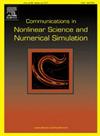Synchronization of Markovian reaction–diffusion neural networks in complex noise settings: A Time-Space control approach
IF 3.4
2区 数学
Q1 MATHEMATICS, APPLIED
Communications in Nonlinear Science and Numerical Simulation
Pub Date : 2025-04-03
DOI:10.1016/j.cnsns.2025.108800
引用次数: 0
Abstract
In this article, the synchronization issue of Markovian neural networks with reaction–diffusion phenomena (RDMNNs) in complex noise environments is studied. Firstly, Lévy noise is incorporated into the model as the stochastic noise source for the system, and the impact of different noise intensities on the stability of the error system is analyzed. Furthermore, the dynamic changes in system parameters are analyzed using Markovian switching theory. Secondly, a Time-Space sampled control (TSSC) strategy is adopted, which integrates time and space dimensional information to address the challenges of diffusion phenomena. This control strategy expands the control dimensions of the controller and enhances the efficiency of system information utilization. Subsequently, an appropriate Lyapunov-Krasovskii functional (LKF) is constructed and Itô formula is employed to derive a less conservative synchronization criterion for both the master and slave systems. In the end, a numerical example is given to verify and support the validity of the theoretical result obtained from the derivation.
复杂噪声环境下马尔可夫反应-扩散神经网络的同步:一种时空控制方法
本文研究了具有反应扩散现象的马尔可夫神经网络在复杂噪声环境下的同步问题。首先,将lsamvy噪声作为系统的随机噪声源引入模型,分析了不同噪声强度对误差系统稳定性的影响;利用马尔可夫切换理论分析了系统参数的动态变化。其次,采用时空采样控制(TSSC)策略,将时间和空间维度信息相结合,解决扩散问题;该控制策略扩展了控制器的控制维度,提高了系统信息利用效率。在此基础上,构造了合适的Lyapunov-Krasovskii泛函(LKF),并利用Itô公式推导出了主从系统的较保守的同步准则。最后给出了一个数值算例,验证和支持了推导所得理论结果的有效性。
本文章由计算机程序翻译,如有差异,请以英文原文为准。
求助全文
约1分钟内获得全文
求助全文
来源期刊

Communications in Nonlinear Science and Numerical Simulation
MATHEMATICS, APPLIED-MATHEMATICS, INTERDISCIPLINARY APPLICATIONS
CiteScore
6.80
自引率
7.70%
发文量
378
审稿时长
78 days
期刊介绍:
The journal publishes original research findings on experimental observation, mathematical modeling, theoretical analysis and numerical simulation, for more accurate description, better prediction or novel application, of nonlinear phenomena in science and engineering. It offers a venue for researchers to make rapid exchange of ideas and techniques in nonlinear science and complexity.
The submission of manuscripts with cross-disciplinary approaches in nonlinear science and complexity is particularly encouraged.
Topics of interest:
Nonlinear differential or delay equations, Lie group analysis and asymptotic methods, Discontinuous systems, Fractals, Fractional calculus and dynamics, Nonlinear effects in quantum mechanics, Nonlinear stochastic processes, Experimental nonlinear science, Time-series and signal analysis, Computational methods and simulations in nonlinear science and engineering, Control of dynamical systems, Synchronization, Lyapunov analysis, High-dimensional chaos and turbulence, Chaos in Hamiltonian systems, Integrable systems and solitons, Collective behavior in many-body systems, Biological physics and networks, Nonlinear mechanical systems, Complex systems and complexity.
No length limitation for contributions is set, but only concisely written manuscripts are published. Brief papers are published on the basis of Rapid Communications. Discussions of previously published papers are welcome.
 求助内容:
求助内容: 应助结果提醒方式:
应助结果提醒方式:


